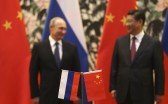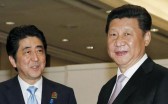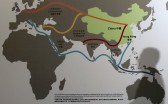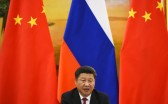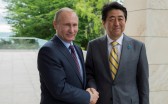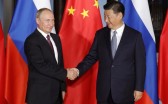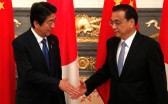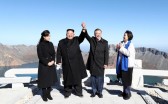In 2009 in New York, a vast program for cooperation between the regions of the Russian Far East and Eastern Siberia, on one side, and Northeast China, on the other, extending to 2018, was adopted by the leaders of Russia and China (Dmitri Medvedev and Hu Jintao). For the realization of this program, they were to carry out economic integration of these two border regions on a qualitatively new level and facilitate economic growth on both sides of the border. The first reaction of the Russian media and expert community to this document was painful, giving vent to the fear that the “Far East would be sold to the Chinese.” Moreover, the program lacked concrete content and appeared to be an “agreement about intentions” without referring to the mechanisms for their realization. The projects on the Chinese side, on the whole, would have been realized even without this program, being part of the strategy for “restoration of the old industrial base of Northeast China.” But the projects on the Russian side amounted to a list of objectives the realization of which would require the attraction of Chinese investments.
The problem here is that attracting Chinese investment in the economy of a Russian region is associated with a large number of obstacles, including negative sentiments of the public, inflexibility of the Russian bureaucratic machine, the presence of unwritten conditions within the controlling organs for not allowing Chinese business into the strategic sectors of the economy, and most important, the low level of attractiveness of the Russian Far East for Chinese investors, who with much more ease and profit put their funds in the economies of Southeast Asia and Africa. As a result, Chinese investments, without which the designated objectives could not be realized, did not take place. Not one of the major objectives foreseen in the program on Russian territory was achieved.
By 2015, everybody had forgot about the above-mentioned program, although the formal timeline for its realization is still under way. By this time, another idea had begun to be actively propagated by the authorities of the two countries—the idea of “convergence” of the projects of the Silk Road Economic Belt (SREB) and the Eurasian Economic Union (EEU), about which the leaders (Vladimir Putin and Xi Jinping) spoke in Moscow. Despite the active exchange of opinions about this over the past year, this idea still has no concrete contents and lends itself to slogans and mantras. Moreover, a large proportion of politicians and experts in Russia again are skeptically inclined, considering the SREB to be a neo-colonial policy of Beijing unfavorable to Russia. In short, all the conditions are in place for the convergence of the SREB and EEU also not to be transformed from mere declarations to real actions and, with time, to be forgotten and replaced with another idea.
Alas, these examples are characteristic of cooperation between Russia and China as a whole, and cooperation between border regions, in particular. In spite of the presence of potential for cooperation and agreement at high levels, actual economic integrations are not visible in the border region. From the point of view of cultural affinity, Russians and Chinese are still very far apart and, more importantly, do not trust each other. This is the objective reality, and it corresponds to the level of economic development of the Russian Far East and Northeast China and to the motivations of the residents of the two regions. It is hard to imagine that in the coming decade anything fundamental will change. Below, I offer my analysis of the sectors that experts view as most promising for cooperation.
Investment and the Attractiveness to Labor.
The main characteristic of which it is necessary to be aware in order to understand the problems of regional cooperation is the fact that both the Russian Far East and Northeast China are peripheral regions of their countries with depressed economies. They lack potential to invest their own resources in the other’s economy. Over a long time the Northeast China provinces held a monopoly position in seeking cooperation with the Russian Far East, amassing significant experience in working with representatives of local authorities and business. However, the activities of the border area Chinese authorities, serving as middlemen in trade, did not result in serious investments from Northeast China. Even less can be expected to occur now, when the tempo of growth of the Chinese economy has slowed, and in some cities of the “rust belt” (as Northeast China is sometimes called), growth is now negative.
Now China, according to official data, does not figure even into the top seven of foreign investors into the Russian Far East.1 Chinese investments are directed at small and middle-sized enterprises, at agriculture, construction, and in the sphere of services. As a rule, they rely on outdated technology and are inclined to violate migration and environmental legislation of the Russian Federation. Naturally, the local population has mixed reactions to these investments, considering that those from Japan, South Korea, and countries of the West have more promise. Big business from Beijing, the Yangtze Delta, and Guangdong province still is only examining the initiative of the Russian government on creating special economic zones (the “Free port Vladivostok” and “territories of priority development”); however, they are in no hurry to invest their money. This is explained by the fact that there is not yet an example of successful investing by a major international business, and there is little trust in the behavior of Russian officials, who too often show a lack of economic expediency.
Chinese investors would like to establish enterprises in the Russian Far East in conditions that would permit them to bring Chinese equipment into Russia tariff free, to utilize unlimited numbers of Chinese workers, and to lessen control by law enforcement organs. These conditions will never prevail in Russia. Chinese are patient negotiators, and they are prepared to wait for a long time until in the future, to the degree the economic position in Russia worsens, Russian officials will be more persuadable. However, Russia is in no hurry to put its state interests under “threat.”
To now the major share of investments in “Free port Vladivostok” and “territories of priority development” comes from Central Russia and offshore, which also, more likely than not, are controlled by Russian businessmen.2 They are not able to provide what is needed for a qualitative leap in the development of the Russian Far East. In conditions of a shortage of labor and weak development of infrastructure, production in the Russian Far East is inadequately profitable. The local market cannot provide the demand, and to take consumer goods to European Russia, equal to taking them to neighboring countries of Asia, given the cost of tariffs, is unprofitable. All could change in the event of the flow into the region of a large volume of foreign (above all, Chinese) investment through conditions capable of interesting investors. However, the local population and, likewise, local authorities prefer the preservation of the status quo rather than widespread access to the region by foreign business and foreign labor, which would have unforeseeable and poorly controlled consequences.
Transport
Apart from reserves of national resources, access to which Russia strives to limit for foreigners, other competitive attractions of the Russian Far East are considered to be its geographical situation and the presence of transport infrastructure able to fulfill the function of a bridge between Asia and Europe. For a long time, this was the ports of the Russian Far East and the Trans-Siberian Railroad—which had a monopoly position in trans-continental logistics. It turned out that the transport infrastructure developed very slowly, which makes Russian ports quite expensive and the railway quite slow. In this situation, the vast majority of merchandise from East Asia to Europe is carried by sea, and all that is allocated to overland transshipment is one percent of the total traffic.3 Considering the volume of trade, this, all the same, would be quite a lot if it created conditions for earning a good return from the transit service.
In the mid-2010s, the Russian Far East lost its unique position on the trans-continental logistics map, since through the efforts of Beijing and Astana the transit route through the western regions of the People’s Republic of China (PRC) and Kazakhstan exiting in European Russia began to be used. Analysis of data for transshipments shows that at present the transit loads across Kazakhstan carry more than those across the Russian Far East and Eastern Siberia.4 In light of the active role of Beijing in economic expansion into Central Asia, one can surmise that the logistical infrastructure there will develop even more dynamically, which will have a tendency to assume an irreversible character. Thus, one can agree with existing calculations that transshipments across the western regions of China and Kazakhstan will, all the same, be losers for Chinese logistical companies and will be subsidized by the government through local budgets .5 Against this background, the appeal of using the “Far Eastern corridor” has, of course, risen (the fall of the ruble has made the added costs in using Russian transport not so high, but the increase in transit across Russia is being restrained by the catastrophic condition of border area infrastructure and the slow process of border and customs procedures).
The authorities in the northeastern provinces of the PRC in accord with the strategy of Beijing for establishing SREB regularly declare their intentions to convert their provinces into “centers of trans-continental logistics.” According to their plans, from central China shipments should move into Northeast China in order, then, to enter the routes of Russia and Mongolia. In this respect, their interests correspond to the wishes of Russian authorities, who also are advancing various projects for the development of transit potential (the big port of Zarubino, the transport corridors “Primor’e-1 and Primor’e-2”). However, all such slogans are uttered for the sake of attracting attention from the center and receiving subsidies to realize their intent. The prospect that they will materialize is minimal—at present, transport by sea or through Central Asia is more profitable and cheaper (at least, as long as the PRC government is ready to subsidize such shipments).
Considering the economic crisis, Russia has no resources of its own for qualitative modernization of the existing logistical infrastructure, and attracting Chinese capital is wrought with a whole range of difficulties, about which I commented above. Besides, Russia would prefer to utilize its own roads and ports for transshipment of its own goods, and not for transit transshipments. In the opinion of many experts, the advantages from such borrowed use of its infrastructure are low, and the side effects, including problems of the environment, are high.
Agriculture and Industry
For the economic development of the Russian Far East, Russian authorities undoubtedly would like to see contemporary, technologically advanced production. The idea that this region could be used only as a supplier of natural resources to foreign economies and as a transit bridge for transshipment of foreign goods frightens Russian society, and Russia is not prepared to accept it. Besides, for reasons noted above (as well as high costs of starting and servicing production, a shortage of qualified cadres, and high labor costs for existing workers), only a dreamer would speak of founding such contemporary firms. Much more realistic is the variant of utilizing the land of the Far East for developing cooperation in agriculture. At present, the region lacks its own resources—labor and financial—for realizing the spread of agricultural production. Russian farmers with whom this author happened to talk in the course of field research in 2014-2015 complained about the fact that wages in agriculture are so low that the local population does not want to work in the fields and prefers to leave for the cities to work in the service sector. At the same time, farmers lack the financial resources to expand production, and procedures for attracting foreign labor are severely complicated by bureaucracy.
Nearby lies the vast, rich China, ready to invest in Russian agriculture, the output from which, thanks to low prices and environmental quality, is becoming more and more popular on the Chinese market. At present, the most successful examples of Chinese investment in the Russian Far East are found precisely in agriculture; however this activity is seriously complicated by a variety of factors. First, these are the very same problems with which Russian farmers are confronted: a shortage of labor resources and bureaucratic difficulties in attracting foreign workers. Today, in conditions where the value of the ruble has fallen by half in relation to the yuan, wages in Russia have stopped being appealing even for poor peasants in border districts of China. This has even more complicated the position of investors. Second, public opinion in Russia reacts negatively to the behavior of Chinese farmers, considering them to cause harm to the surrounding environment and their production to be harmful. Such conclusions have some truth, since Chinese farmers now work in Russia in a “temporary existence .” They rent land for a short period (often illegally, working the land in the guise of hired laborers), can easily be deported from the country, or will not receive permission when new workers are hired for the following year. All this leads them to live “only for today,” striving to extract maximum profit here and now. They would behave more responsibly if they had confidence in the long-term nature of their work, having long contracts for land rental. Yet, analysis of the mass media in 2015 demonstrates that this is practically impossible in light of the level of xenophobia and feelings of “yellow peril” in Russia. In response to the declaration of one border region of its intention to rent to Chinese investors 115,000 hectares of unfarmed land for 49 years, public opinion went hysterical, and it was backed by deputies in the State Duma.6 As a result, these plans were not realized (at least, officially), and authorities in other regions were given to understand that they would be subject to severe criticism should they rent out land to Chinese on a long-term basis.
The results of sociological surveys testify to a gradual change in public opinion regarding China and Chinese investments: Russia would be pleased with Chinese investments, but only in contemporary sectors and without attracting Chinese labor.7 Unfortunately, for economic reasons, this is not profitable. Thus, one fears what would be beneficial for all in the attraction of Chinese capital into Russian agriculture; the perspective for the development of cooperation in this direction is still cloudy.
Conclusion
The skeptical tone of the prognoses above are based on the multi-year experience of the author in analyzing existing agreements and their realization in practice. The Russian Far East and Northeast China are places where lots of words are spoken, but they almost never turn into actions. The two areas are developing on separate plains, not paying much attention to each other. Although Northeast China is one of the least developed regions in China, on all parameters it is ahead of the Russian Far East in development due not to its cooperation with Russia, but its integration into the Chinese market and the subsidies it gets from Beijing. Those economic successes that are present in the Russian Far East have been due to the sell of energy resources or from huge financial inputs by Moscow. The local authorities on both sides of the border talk a lot about international cooperation because they should talk about this, but they do not have real interest in it, since the benefits from such cooperation are not apparent, and the risks (especially for the Russian side) can be very great.
The absence of trust between partners leads to the fact that, in practice, for local authorities imitating being active is more advantageous than actually being so. While I do not conclude that things will get worse, I do not expect them to get much better when for a large part of the population (and perhaps for the state), keeping the status quo is a desired result.
1. Alexander Gabuev and Vita Spivak, “Perenosstrakhov: stoit li opasat’sia Kitaiskikh zavodov na Dal’nem Vostoke?” Moscow Carnegie Center, http://carnegie.ru/commentary/2016/05/12/ru-63550/iy6s.
2. “Russian Far East witnesses an investment boom—officials,” Russia Beyond the Headlines, May 6, 2016, http://rbth.com/business/2016/05/06/russian-far-east-witnesses-an-investment-boom-officials_590989.
3. A. K. Ordabaev, Geopolitika transportnykh koridorov v Tsentral’noi Azii (Astana-Almaty, 2015), 9.
4. For details see: I. Zuenko, “Is Russia losing its logistics edge?” Moscow Carnegie Center, http://carnegie.ru/commentary/2016/05/10/is-russia-losing-its-logistics-edge/iy5b.
5. “各路中欧班列靠政府补贴艰难维生 几乎全线亏损,” Huanqiuwang, September 2015, http://finance.huanqiu.com/roll/2015-09/7552303.html.
6. A. Gabuev, “Medved’ na sene: chem opasna sdacha v arendu Kitaiu zemli Russkoi,” Moscow Carnegie Center, http://carnegie.ru/2015/06/22/ru-60453/ijsb.
7. V. L Larin and L.L. Larin, “Vostochnaia Aziia v obshchestvennom mnenii Tikhookeanskoi Rossii (po itogam oprosa 2013),” Rossiia i ATR, no. 2 (2014): 5-19.

